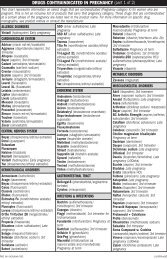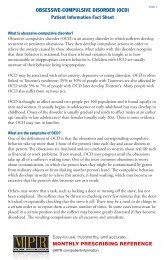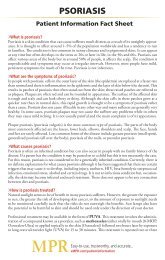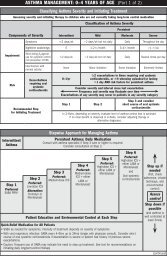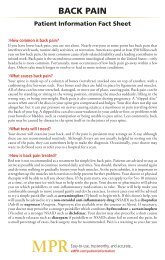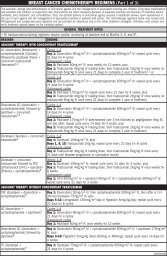VAGINAL INFECTIONS - MPR
VAGINAL INFECTIONS - MPR
VAGINAL INFECTIONS - MPR
You also want an ePaper? Increase the reach of your titles
YUMPU automatically turns print PDFs into web optimized ePapers that Google loves.
Trichomoniasis is caused by a tiny parasite and is sexually transmitted. The symptoms<br />
start between four days and three weeks after contact with an infected person. It causes<br />
a thin, yellow or green discharge, which may be frothy and have an unpleasant “fishy”<br />
smell. Again, a vaginal swab is usually required to confirm the diagnosis. Sometimes<br />
there are no symptoms.<br />
PAGE 2<br />
Gonorrhea is caused by bacteria and is sexually transmitted. It may not always cause<br />
symptoms. If it does, the symptoms may be a sore throat, pain or discomfort when<br />
passing urine and a thin, watery, yellow or green vaginal discharge. It is not usually<br />
detected during cervical smear tests or routine health checks if there are no symptoms.<br />
If a sexual partner has gonorrhea, it is important for the other partner to be tested even<br />
if they do not have any symptoms. If symptoms clear up without treatment it is still vital<br />
for the infection to be treated. Gonorrhea can be cured with antibiotics but, there is<br />
increasing risk of antibiotic resistance. If symptoms do not improve with treatment, the<br />
patient should return to their doctor for reevaluation. Gonorrhea can spread inside the<br />
body and can cause pelvic inflammatory disease (PID) in women. PID can cause<br />
infertility. A gynecological exam is strongly recommended.<br />
Chlamydia is a sexually transmitted infection caused by bacteria called Chlamydia<br />
trachomatis. Infected persons often have mild symptoms or none at all. Most people<br />
do not get tested until complications arise. In those that do get symptoms, these usually<br />
occur around a month after infection and include pain or stinging when passing urine, a<br />
milky or mucus-like discharge, pain during sexual intercourse, bleeding between periods<br />
and stomach pain. If left untreated chlamydia can cause PID and may affect fertility. A<br />
vaginal culture is required to confirm the diagnosis.<br />
How are vaginal infections treated?<br />
A yeast infection is treated with antifungal creams that are applied locally to the area<br />
surrounding the vagina or with antifungal suppositories or cream inserted into the<br />
vagina. Often a combination of the two is used. Examples of topical antifungal agents<br />
used to treat yeast infections include clotrimazole, terconazole, miconazole and nystatin.<br />
Many treatments for yeast infections are available to buy from a pharmacy without a<br />
prescription.<br />
Treatment for bacterial vaginosis is with antiprotozoal-antibacterial tablets containing<br />
either tinidazole (Tindamax) or metronidazole (Flagyl). Metronidazole is also available<br />
as a vaginal gel called Metrogel. A cream containing clindamycin (Cleocin Cream) may<br />
also be prescribed.<br />
Easy-to-use, trustworthy, and accurate...<br />
MONTHLY PRESCRIBING REFERENCE<br />
e<strong>MPR</strong>.com/patientinformation









